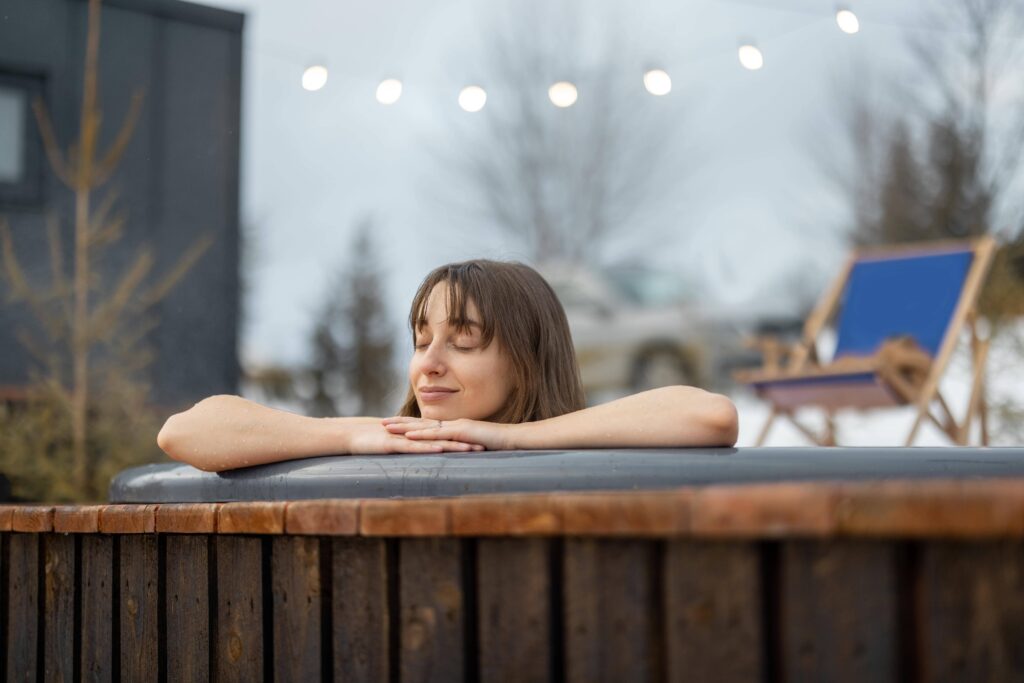
Looking to transform your wooden hot tub into a truly incredible spa experience? Of course, the quality of the tub itself comes first, but after that, there is a wide range of hot tub accessories and modifications you can make to elevate your spa sessions to the next level. Check how much effort and innovation in this regard Royal Tubs, Gardenvity, Skargards, Kirami and Timberin put into their products.
Some of these different features and systems that accessories offer are practical, with the aim of easing the amount of maintenance required, while others are simply there with pure luxury in mind for the utmost spa enjoyment.
Leaving the essentials aside (such as the heater, liner or water filtration systems which we discussed in this article here), let’s explore accessories as massage systems, LED lighting, covers and more that are available for wood-fired hot tubs. You may consider adding them to your shopping cart once you learn about their functions and benefits.
Types of massage systems:
Hydro and air
The main tangible difference between a hydro or air massage is that hydro jets create stronger currents for a deeper, more focused massage for your body, while air jets provide a more gentle tickling or caressing sensation.
When it comes to maintenance, the differences are even greater.
Air jet spa
Air jet spa systems include an air pump which circulates air in tiny tubes and expels it through the nozzles. Air bubbles are then launched into the water, creating a gentle massage sensation for you. Although the water does not circulate through the pump and the pipework, a minimal amount can get into the system through the nozzles. The air jet system is safe as long as you make sure to blow out all of the water after draining the hot tub. This is especially necessary in subzero temperatures. Remember to switch the system on for even just 30 seconds, and you’re safe.
Hydro jet spa systems
Hydro jet spa systems are a different breed. These use a more powerful water pump to circulate water in the lines and thrust it through the nozzles. As a result, the system is always filled with water which can freeze and facilitate a buildup of bacteria whenever the water currents stop.
To protect the system against unwanted damage that can be unavoidable when the water cools down and freezes, it requires the same kind of maintenance as with the air jet system. Just switch on the hydro jets for 30 seconds or so when the hot tub is drained and blow out any water residue.
To protect the pipework from biofilm formation while regularly maintaining the proper chemical balance of the water, you also need to add one more job to the hot tub maintenance schedule: flushing the hydro system with specific chemicals. This maintenance task must be completed each time before you drain the water and every three months at a minimum. Otherwise, the bacteria buildup (or gunk, as you might call it) will reduce the massage effectiveness due to the pipe diameter becoming reduced or clogged. It can also cause bacteria to circulate throughout the hot tub, decreasing disinfection efficiency and degrading the water quality.
Call the seller and inquire about the technical details before you purchase to ensure you are able to maintain your hot tub in the right way.

Types of covers
Does the type of cover have much of an impact on your overall hot tub experience? It sure does.
You will typically be presented with three main cover options when purchasing a hot tub:
- Insulated artificial leather cover (this is often able to be folded over)
- Plastic or fibreglass (more lightweight than wooden)
- Wooden
It would be best to go in-store and check out the covers or lids for yourself, as they can look different than the photos on the website, but not all wood-fired hot tub brands have showrooms.
Without beating around the bush here, our top recommendation is an artificial leather insulated cover. This is based on several key reasons.
Firstly, a leather cover offers superior insulation compared to the other options. This means it plays a vital role in speeding up water heating time and maintaining the water at a toasty temperature through the night for use the next day.
Secondly, this type of cover is lightweight enough to be manoeuvred by a single person. This makes it easy to use for a solo spa session without needing an extra pair of hands to help with lifting it and placing it back on afterwards.
The downside, however, is that even the best quality artificial leather cover should not be left shut without opening the hot tub, as there can be enough residual moisture in a drained hot tub that can cause mould to form on the cover. If this happens, extra effort is required to get rid of the mould compared to simply scraping or scrubbing it off a wooden lid, for example. Higher quality artificial leather covers will have holes punched at the bottom to allow condensation to drip away and improve the cover’s longevity.
Some lower-quality artificial leather covers are not able to support the snow load if you live in an area that experiences heavy snow. The relative weakness of these covers also means that it won’t be able to withstand kids playing on it, as odds are it will break.
Another issue with lower-quality artificial leather covers is that you will need to check whether they are tapered so as to allow water to run off the top of the cover. Water can pool on the cover and stay there if it is completely flat (not tapered). Check with the manufacturer if they have designed the cover to prevent that from happening.
A plastic or a fibreglass lid will typically have no problem with water pooling on top of it, as they are mostly concave in shape. Mould will also be unable to penetrate the lower side of the cover too much if you forget to open the hot tub to allow it to dry out completely. However, the weight of a plastic or fibreglass lid can make it too heavy and complicated for just one person to lift. Time and time again, we have seen stubborn owners try to lift the lid themselves, only to find that it’s trickier than it seems. When handling the lid from only one side and sliding it down from the tub, it is likely to scratch the edges of the liner so extra care, or an extra pair of hands, can be necessary.
Most of what has been said about plastic lids also applies to the wooden option, except a wooden lid is heavier and can be less durable if not suitably treated against moisture and environmental effects.
LEDs and other hot tub accessories
Underwater lighting adds an ambience of romance and playfulness to a hot tub experience. Options typically include one or more large LEDs, or several smaller points of light. You can also opt for both! When configuring your hot tub package, most brands will charge around £140 to £300 to include LED lighting. If you browse Amazon, you can also find LEDs for hot tubs that come in the form of independent battery-operated submersible or floating units. These will provide light effects but will not offer the exact seamless design synchronisation as the units that the manufacturer can specifically build into the design of your hot tub.
An essential feature of any hot tub is steps, as you wouldn’t be able to get into the tub without them. Make sure you don’t forget to include this feature in your shopping cart. Some brands like Gardenvity or TimberIN add basic steps to your package at no extra cost. If you are seeking more luxury or larger options, you can choose to upgrade to these. However, the majority of other brands will show the ‘from’ price for a hot tub with no steps included, so they can be a costly add-on.
Drink bars, side shelves and similar inventions are also popular additions to a wooden hot tub, since any hot tubber tends to be inseparable from a glass of their beverage of choice while soaking. You will want to make sure you keep your drink close to the water. One option is to attach a wooden side-bar to the wood cladding of the hot tub. Some brands may sell a floating bar or a rotating shelf fixed at the side.
Railings are not a typical feature of wooden hot tubs. Still, the increasing popularity and narrowing of the gap between wooden hot tubs and electric jacuzzi-type hot tubs has encouraged the use of such customisable features. For elderly users, or those with limited physical ability, a railing may prove an extremely handy feature to ensure greater safety.
Features like towel racks or headrests, while not essential, will further add to a pleasant and enjoyable hot tubbing experience.
Do all hot tub producers offer these accessories?
This information will need updating from time to time as hot tub producers can rapidly change their products on offer, responding to market trends. As of June 2022, the below information has been confirmed based on the online product descriptions available from top wood-fired hot tub brands, taken from their UK websites.
As we mentioned at the start of this article, rather than focusing on any of the key parts of wood-fired hot tubs, we are instead reviewing accessories that add functionality, ease of use, comfort or luxury. Here is a list of the accessories offered by each of the top brands in the UK that you could add to your ideal hot tub.
Skargards
Air jet massage system
Insulated artificial leather lid
One underwater LED
Side shelf
Chimney extension, heat guard and rain cowl
Hearth plate
One type of steps
Gardenvity
Air jet and/or hydro massage systems with a customisable number and position of nozzles
Insulated artificial leather lid
One large and/or 10 mini LEDs
Side shelf for drinks with a metal glass holder
One-metre chimney extension, heat guard and rain cowl with an ash catcher mesh
Hearth plate
One type of steps
Headrest
Hand railing
Towel bar
Brass hose fittings
Stirring paddle
Royal Tubs
Air jet and/or hydro massage systems
Insulated artificial leather or wooden lid
One large big LED
Side shelf for drinks
Chimney heat guard and rain cowl
Two types of steps
Stirring paddle
The Log Company (Kirami)
Hydro massage system
Insulated artificial leather, plastic or wooden lid
LEDs (unspecified number)
Side shelf for drinks
Floating drink stand
One-metre chimney extension, heat guard and rain cowl
Hearth plate
Ash shovel
Four types of steps
Stirring paddle
Headrest
TimberIN
Air jet or hydro massage system
Insulated artificial leather, fibreglass or wooden lid
One to four LEDs
Side shelf for drinks
Chimney heat guard and rain cowl
Four types of steps
Stirring paddle
Garden hose adapter
That brings us to the end of this list of accessories used in wood-fired hot tubs.
We believe it’s worth considering your unique circumstances and exploring all available options to decide what will suit your needs when it comes to a home spa experience. It is best to think about this when buying a hot tub, as ordering accessories later can incur extra shipping costs and delay the time before you get to use your new hot tub to its fullest, most relaxing and luxurious potential.
We’re here to show you around and help you get a glimpse into what the top wood-fired hot tub brands have added to their menus so that your choice is better informed.
Check out more of our articles discussing other important features and systems present in modern wood-fired hot tubs and find side-by-side brand comparisons all in one place to help you make the right decision for your needs.

